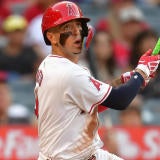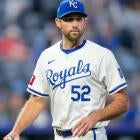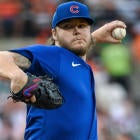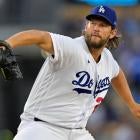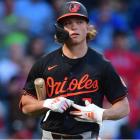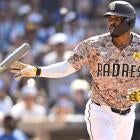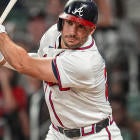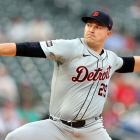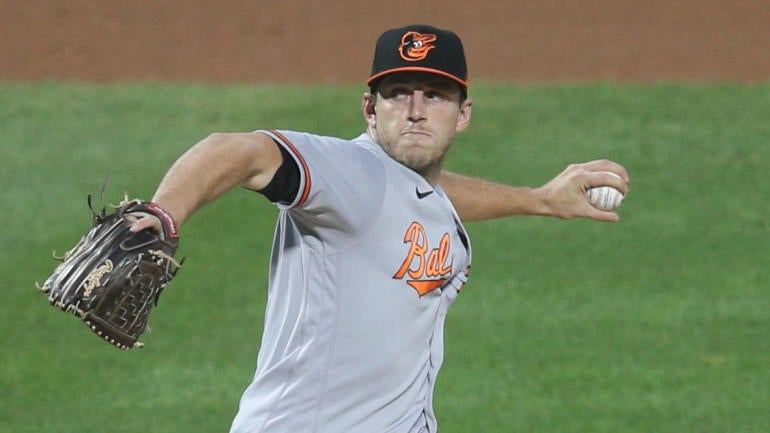
You don't need me to remind you how crazy things were in September.
Football was beginning with its usual gusto. Election season was building to a fever pitch. Parents and children were at each other's throats in between Zoom calls, still learning to navigate the intricacies of virtual school. And then there was baseball thundering through what was basically the second half of its pint-sized season.
It may not have been at the forefront of your mind. In fact, you may have skipped out on baseball entirely given the challenges surrounding the season. But whether you tuned out for one month or both, what you missed was consequential.
These developments came so late that they're not so clearly reflected in the season-long numbers, even as short as the season was, but their imprint could be a lasting one. You wouldn't want to let them sneak up on you.
Surprising pitchers
- Royals rookie Brady Singer upped his slider usage over his final four starts, leaving his changeup behind to focus on tunneling his fastball and slider, and the two played off each other well. There was one misfire among those four starts, but he was nothing short of brilliant in the other three, allowing a combined six hits over 21 innings. In all, he had a 1.50 ERA, 0.71 WHIP and 9.4 K/9 during that four-start stretch, his ground-ball rate remaining an impressive 53.7 percent. Frankly, his overall numbers — a 4.06 ERA, 1.17 WHIP and 8.5 K/9 — landed in a respectable place, but it was that strong finish that brought them there.
- Something changed for John Means last year, his average fastball velocity rising 2 mph, and the effect wasn't fully realized until his final four starts. It began with a jump in swinging-strike rate, from 9.0 percent in his first six starts to 15.7 percent in the final four — opposite ends of the spectrum, basically. The strikeouts followed in his final two, a combined 21 in 11 2/3 innings. Between those four starts, he had a 1.52 ERA, 0.63 WHIP and 11.4 K/9. He's always been an excellent strike-thrower. If he's becoming even an above-average bat-misser, it's a game-changer.
- Drew Smyly missed a solid stretch of the season with a strained finger, which meant he was only able to build up to five innings for his final two starts. But like Means, his fastball velocity was way up from the get-go, about 2.5 mph higher than in 2019, and he was piling up strikeouts in abbreviated starts because of it, finishing with 14.4 K/9 and a 14.9 percent swinging-strike rate that would have ranked eighth among qualifiers. He's 31 at this point, and it may turn out to be just a blip. But there was a time when he looked like the next big thing, so maybe the breakout is finally happening, as we saw with Kevin Gausman.
- Chris Bassitt put together a 2.29 ERA and 1.16 WHIP in 11 starts, but there's a question of how sustainable it was. His 4.49 xFIP doesn't paint a favorable picture, and he had just 7.9 K/9, his 9.9 percent swinging-strike rate ranking in the bottom quarter of the league. But his final three starts were his best in that regard, combining for a 14.9 percent swinging-strike rate. He also went six-plus in each of them — something he did only five times total — so it's like he found another gear entirely. It's enough to give doubters like me some reason for pause.
- Rookie Tanner Houck was so effective in three starts for the Red Sox that it's a wonder they didn't turn to him sooner. In all, he gave up one run on just six hits over 17 innings while striking out 21, including 10 in his final start against the Braves. His slider looks like it could be a legitimate weapon. Of course, his swinging-strike rate wasn't so impressive apart from that Braves start, and he also walked nine in those 17 innings. His minor-league track record is uninspiring and his prospect standing unimpressive. He'll get some hype this year, but I'm not sure it'll come from me.
- Daniel Ponce de Leon was surprisingly dominant in his final three starts, striking out nine in two of them and allowing just one hit in the other. Between the three, he had a 65 percent strike rate and a 15.2 percent swinging-strike rate, which would both be elite. The 28-year-old has an inconsistent track record both in the majors and minors, mostly because of his inability to throw strikes consistently, but the fastball is a legitimate weapon if he does learn some control. He'll probably be on the outside looking in at the start of 2021, but there may be a rotation spot or two up for grabs in spring training.
- Mitch Keller's three starts after returning from a strained oblique saw his velocity come closer to where it was in 2019, which is a relief. The performance in those three starts wasn't especially revelatory — at least in the ways I normally assess pitching ability — but it is noteworthy that he didn't allow a hit in either of his final two starts, spanning 11 innings. Of course, he did issue eight walks in one of them, so ...
- It might be time to give Adbert Alzolay another look, provided the Cubs do. The 25-year-old, who got some attention last year with back-to-back one-hit outings to begin his career, closed out this season with back-to-back two-hit efforts, striking out 15 over nine innings. It's a spotty minor-league track record, but he has gotten some prospect hype in the past. And now he has a new slider that appears to be his best swing-and-miss pitch.
Surprising hitters
- Jared Walsh homered nine times in 20 games down the stretch, likely cementing himself as the Angels' opening day first baseman this year. The power itself isn't so shocking. He did, after all, hit 36 home runs in the minors last year and 29 the year before. That he got to it so much is surprising. The 27-year-old had the look of a Quadruple-A type player after striking out 40.2 percent of the time in limited exposure last year, but his 13.9 percent strikeout rate in 108 plate appearances this year would have been the 15th-best among qualifiers.
- Tigers shortstop Willi Castro had some prospect standing coming into 2020, but not the sort that would explain him hitting .349 with six homers and a .932 OPS in 129 at-bats. The plate discipline was lacking, and the quality of contact left something to be desired. Still, it wouldn't surprise me if he turned out to be more Jean Segura than Niko Goodrum.
- The rookie leader in WAR wasn't who you think it was, unless you think it was Ke'Bryan Hayes. Defense had a hand in it, yes, but the third baseman, who didn't see any action until Sept. 1, ended up hitting .376 with five homers and a 1.124 OPS in 85 at-bats, spraying line drives to all fields with consistent hard contact. He was one of those prospects whose numbers never lived up to his ranking, which made it difficult to buy into him fully in Fantasy, but he'll have his share of backers heading into next season
- The world needs more catchers who can hit, and Sam Huff might just fit the bill. He earned a 70 power grade from Baseball America at the start of the year and put it on full display during a late-season trial with the Rangers, hitting three home runs and three doubles in 10 games. While he batted .355 (11 for 31), plate discipline could be an issue and may ultimately render him a Tom Murphy clone, but at that position, you'd take it.
- Jackie Bradley ended up hitting a career-high .283 thanks in large part to a big September in which he batted .326 (29 for 89) with five homers, five steals and a .985 OPS. His lengthy track record should obviously count for more than one hot month, and his expected stats, according to Statcast, don't really back the breakout. But his line-drive rate was way up in September, and hey, it's noteworthy regardless, especially with the five stolen bases. He's a free agent still looking to join up with a team this offseason, and a change of scenery might do him some good.
Disastrous finishes
- Luis Robert was batting .298 with 10 homers and a .960 OPS at the end of August and looked like he might be in contention for a second- or third-round pick, but then went on to hit .136 with one homer and a .409 OPS in September. Those strikeouts, I tell ya.
- Fernando Tatis greatly improved his strikeout rate in his second season, but he still came crashing down with a .164 (9 for 55) batting average and .533 OPS over his final 16 games. The good news is that he underperformed his expected stats this time around. They pegged him for a .298 batting average and .612 slugging percentage while he finished at .277 and .571. He'll still be a top-five pick, at least in 5x5 leagues.
- Aaron Nola's redemptive season ended on a sour note, with three consecutive not-so-flattering starts. It wasn't enough to ruin his season line — he still had a 3.28 ERA, 1.08 WHIP and 12.1 K/9 — but it was 2.40, 0.89 and 12.3 going into those three. Given his uneven 2019, the bumpy finish is enough to drop him to the lower end of the top 10 heading into this year.
- A slightly altered pitch selection looked like it was generating more whiffs for Aaron Civale at the start of the year, when he put together a 3.15 ERA, 1.03 WHIP and 9.0 K/9 in his first six starts, but it was all a mirage. He went on to have a 6.62 ERA, 1.68 WHIP and 7.7 K/9 over his next six.
- Kyle Lewis was sort of the hitter version of Civale, finally reeling me in when he was still hitting .350 and showing greatly improved plate discipline as late as Aug. 27. So of course, he went on to hit .147 in September, striking out 37.1 percent of the time.
- Turns out Seth Lugo may not be so equipped to start after all. His transition to the rotation seemed to be going well at first, but two of his final three starts were abject disasters, inflating his ERA from 2.63 to 5.15. It still seems like he has the right arsenal for the role, but here's betting the Mets put a stop to it and keep him in relief in 2021.
- It would be easy to break Dane Dunning's season down this way: a 2.33 ERA in his first five starts and a 10.29 ERA in his final two. But what it misses is that he went from being a bat-missing maniac in his first three starts, with a swinging-strike rate of 17.5 percent, to a wimpy pitch-to-contact guy in his final four, with a swinging-strike rate of 6.9 percent. That his two best starts happened to come during that second stretch is coincidental. The dip in swinging strikes coincides with a change in pitch selection. He began fading his best two pitches (the four-seamer and slider) for more of his worst two (the two-seamer and changeup). Hopefully, he was just a victim of wayward coaching and it's been remedied with his move to the Rangers.
Partial redemptions
- Maybe Adalberto Mondesi's miserable start to the season was a matter of him bouncing back from shoulder surgery. He went on to hit .356 with a 1.075 OPS in September after hitting .186 with a .451 OPS before then, and the end result of .256 and .710 is perfectly satisfactory for someone with his steals potential.
- Lance McCullers, himself coming back from surgery last year, was a different pitcher in three starts after returning from an IL stint for a separate neck injury this year, allowing no earned runs in 17 2/3 innings while striking out 24. It brought his season ERA down to 3.93, and notably, he went back to throwing his curveball about 50 percent of the time in two of those starts, which was a key to his success before Tommy John surgery.
- Frankie Montas reeled off six straight replacement-level starts before ending the year with a 13-strikeout effort against the Mariners in which he allowed no earned runs in six innings. Manager Bob Melvin said the right-hander got back to pitching angry after overthinking his mechanics and pitch selection all season, which isn't the sort of thing we can verify, unfortunately. But his swinging-strike rate was similar to last year's, and he ended up throwing his splitter a decent amount. Maybe he's not a lost cause.
- Madison Bumgarner is more likely a lost cause given the 3 mph dip in average fastball velocity, but it's worth noting he finished the year with two consecutive scoreless starts in which he allowed two hits in five innings. He's only 31 years old and has the sort of never-say-die attitude that might help him find a way to remain useful in spite of diminished stuff, sort of like Adam Wainwright has. Still, I imagine he'll go undrafted in most mixed leagues this year.


